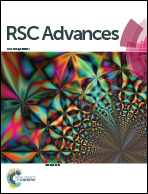Study on the anti-abrasion resistance of superhydrophobic coatings based on fluorine-containing acrylates with different Tg and SiO2†
Abstract
Fluorine-containing acrylates (FACs) with different glass transition temperature (Tg) were synthesized by solution copolymerization, and then the superhydrophobic coatings were fabricated based on the FAC, micro-SiO2 (M-SiO2) and nano-SiO2 (N-SiO2) particles through a two-step spray method. The prepared FAC was characterized by Fourier transform infrared spectroscopy (FTIR), proton nuclear magnetic resonance (1H-NMR) and differential scanning calorimetry (DSC). The wetting behavior and surface morphology of the superhydrophobic coating were studied. The resistance and mechanism of the superhydrophobic coating against abrasion were also investigated. FTIR and 1H-NMR showed that the fluorinated-containing monomer had copolymerized with the acrylate monomers, and FACs with different Tg of about 74.2 °C, 24.5 °C, −7.7 °C and −29.5 °C were prepared. After coating with FAC/M-SiO2/N-SiO2 composite coating, the surface showed hierarchical structures with a roughness (Sa) of 1.23 mm, and became superhydrophobic with a water contact angle higher than 150° and a low sliding angle lower than 5°. Abrasion testing showed that the superhydrophobic coating fabricated based on the FAC polymer with low Tg had better abrasion resistance in comparison with that of the FAC polymer with high Tg. Meanwhile, the M-SiO2 in the composite coating could weaken the abrasion force to the surface micro roughness damage and acted as connections for the adhesion of N-SiO2 particles during abrasion, which ensured the binary micro/nano structures required for good hydrophobicity after abrasion.



 Please wait while we load your content...
Please wait while we load your content...